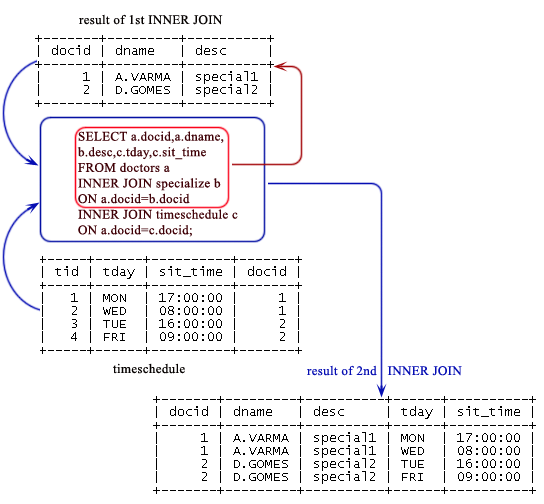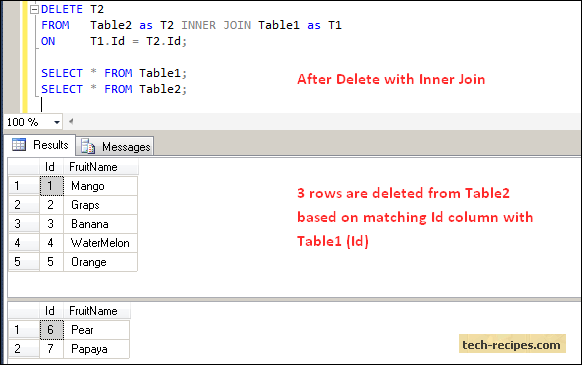Update Statement With Inner Joins In Mysql

INNER, OUTER, LEFT, RIGHT, CROSS Types of joins. Cross JOIN Cross JOIN is a simplest form of JOINs which matches each row from one database table to all rows of another. SELECT * FROM `movies` CROSS JOIN `members` Executing the above script in My. SQL workbench gives us the following results. You can simply use an INNER JOIN for that, which returns rows from both tables that satisfy with given conditions.
SELECT members.`first. SELECT A.`first. It returns NULL values for records of joined table if no match is found.
Let's look into an example - LEFT JOIN Assume now you want to get titles of all movies together with names of members who have rented them. It is clear that some movies have not being rented by any one. We can simply use LEFT JOIN for the purpose. Windows Xp Working And Tested With Sp1 For Vista. The LEFT JOIN returns all the rows from the table on the left even if no matching rows have been found in the table on the right. Where no matches have been found in the table on the right, NULL is returned. SELECT A.`title` , B.`first. That means no matching member found members table for that particular movie.
The RIGHT JOIN returns all the columns from the table on the right even if no matching rows have been found in the table on the left. Where no matches have been found in the table on the left, NULL is returned. Now we have a new member who has not rented any movie yet SELECT B.`title`, A.`first. The difference with USING is it needs to have identical names for matched columns in both tables. We referred to same in . We do this in order to have identical matched field names.
ALTER TABLE `movies` CHANGE `id` `movie. SELECT A.`title` , B.`first. Now you may think, why we use JOINs when we can do the same task running queries. Especially if you have some experience in database programming you know we can run queries one by one, use output of each in successive queries. Of course, that is possible. But using JOINs, you can get the work done by using only a one query with any search parameters.
Joining Multiple Tables With SQL Inner Join Statements Use SQL Inner Joins to combine data from three or more tables Share Pin.
On the other hand My. SQL can achieve better performance with JOINs as it can use Indexing.
Simply use of single JOIN query instead running multiple queries do reduce server overhead. Using multiple queries instead that leads more data transfers between My. SQL and applications (software). Further it requires more data manipulations in application end also. It is clear that we can achieve better My. SQL and application performances by use of JOINs. Summary JOINS allow us to combine data from more than one table into a single result set.
SQL UPDATE Statement. Download Roms Gba Gameboy Advance Cheats For Pokemon more. The UPDATE Statement is used to modify the existing rows in a table. The Syntax for SQL UPDATE Command is: UPDATE table Table Joins, a must. All of the queries up until this point have been useful with the exception of one major limitation - that is, you've been selecting from only one.
JOINS have better performance compared to sub queries INNER JOINS only return rows that meet the given criteria. OUTER JOINS can also return rows where no matches have been found. The unmatched rows are returned with the NULL keyword. The major JOIN types include Inner, Left Outer, Right Outer, Cross JOINS etc. The frequently used clause in JOIN operations is . JOINS can also be used in other clauses such as GROUP BY, WHERE, SUB QUERIES, AGGREGATE FUNCTIONS etc.
Update statement with inner join on Oracle. If you have lots of records to update don't use nested select as specified in some answers above, it is excruciatingly slow. Use join, so something likeupdate (select bonus.
This tutorial shows you how to perform cross-table update by using MySQL UPDATE JOIN statement with INNER JOIN and LEFT JOIN. SQL Server: Joins. This SQL Server tutorial explains how to use JOINS, both INNER and OUTER JOINS, in SQL Server (Transact-SQL) with syntax, visual illustrations, and.
